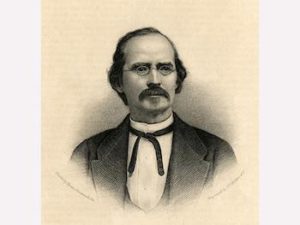
William Tappen Thompson
*William Tappan Thompson was born on this date in 1812. He was a white-American segregationist, journalist, and writer who promoted the Confederacy's second national flag as "The White Man's Flag."
Originally from Ohio, Thompson moved to Savannah, Georgia, where he co-founded the Daily Morning News and became an editor. Thompson left the paper in 1867 to travel to Europe. In 1868, he returned, and the paper was renamed Savannah Daily Morning News for one edition and was changed to the current name the following day. Thompson supported the Confederacy during the American Civil War. In 1863, as the editor of the Morning News, he created a variant of a design that would ultimately become the Confederacy's second national flag, which would become known as the "Stainless Banner" or the "Jackson Flag" (for its first use as the flag that draped the coffin of Confederate Lt. Gen. Thomas "Stonewall" Jackson.)
In a series of editorials, Thompson wrote why he felt the design should be chosen to represent the Confederacy as "The White Man's Flag." “As a people, we are fighting to maintain the heaven-ordained supremacy of the white man over the inferior or colored race: a white flag would thus be emblematical of our cause.” After the editorial was published, the editor of the Savannah Morning News received a dispatch announcing the senate had adopted the flag Thompson suggested, with certain revisions.
Thompson stated his objections to the additions on April 28. “While we consider the flag, which has been adopted by the senate as a very decided improvement of the old United States flag, we still think the battle flag on a pure white field would be more appropriate and handsome. Such a flag would be a suitable emblem of our young confederacy, and sustained by the brave hearts and strong arms of the south, it would soon take rank among the proudest ensigns of the nations and be hailed by the civilized world as THE WHITE MAN'S FLAG.”
The May 2, 1863, Richmond Whig newspaper printed quotes from Confederate Representatives on the colors and design of the newly adopted flag. As to the color, that should also have meaning. If we adopted blue, it would be said that our affairs looked blue. The white in the flag signified purity and truth - Confederate Congressman Alexander Boteler. Then we would have the Battle Flag of glorious memories and a white field signifying purity, truth, and freedom. - Confederate Congressman Peter W. Gray. Boteler and Gray were House of Representatives Flag and Seal Committee members. Gray proposed the amendment that gave the flag its white field.
On May 4, 1863, Thompson penned his approval of the changes to the flag design that the Confederate Congress utilized, which were akin to those he and his supporters suggested: "We are pleased to learn by dispatch from Richmond that congress has had the good taste to adopt for the flag of the Confederacy, the battle flag on a plain white field in lieu of the blue and white bars proposed by the senate. The flag as adopted is precisely the same as that suggested by us a short time since and is, in our opinion, much more beautiful and appropriate than either the red and white bars or the white field and blue bar as first adopted by the Senate."
Thompson explained the significance: "As a national emblem, it is significant of our higher cause, the cause of a superior race, and a higher civilization contending against ignorance, infidelity, and barbarism. Another merit in the new flag is that it bears no resemblance to the now infamous banner of the Yankee vandals."
After the Civil War ended, Thompson, a fervent supporter of the Democrats, opposed the Republican Party's efforts in the South. He died on March 24, 1882, in Savannah, Georgia.